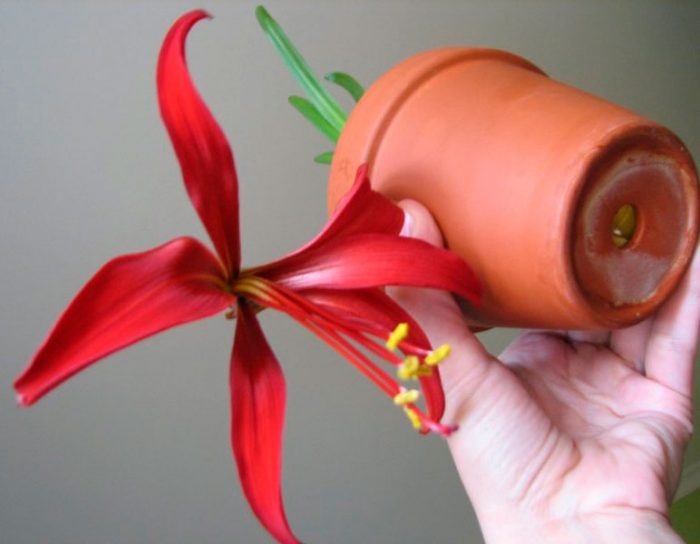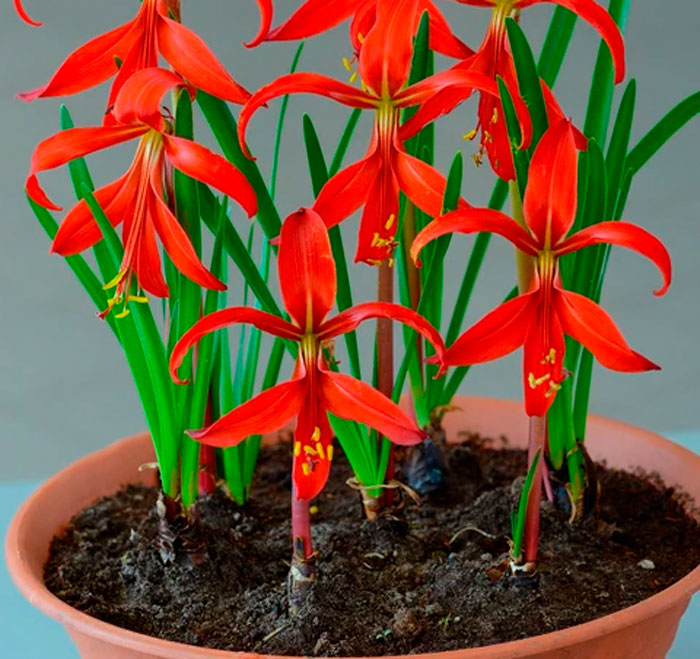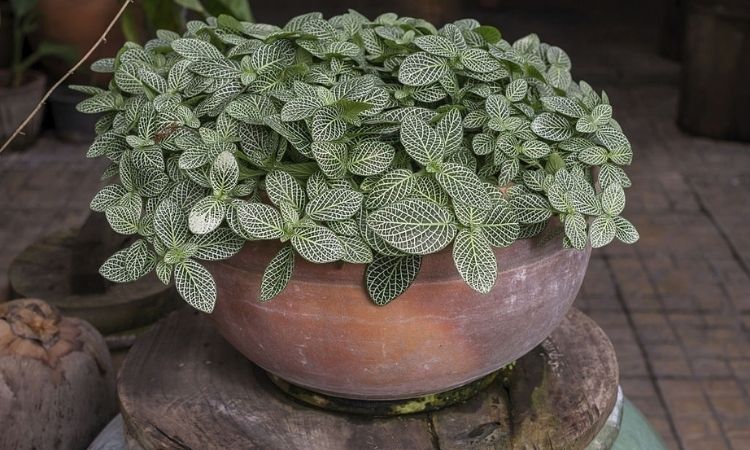Sprekelia (Aztec Lily)
The beautifully flowering Sprekelia plant, also called Aztec Lily, stands out for its spectacular graceful flowers. This evergreen bulbous plant is a member of the Amaryllis family. This genus unites only two species, namely: the Magnificent Sprekelia (Sprekelia Howardii) and the Most beautiful (Sprekelia Formosissima).
It comes from Guatemala and Mexico, and in European countries, it began to grow in 1593. An adult bush reaches a height of about 30–35 centimeters. Flowering begins in the spring months or June. At this time, a peduncle appears on the bush, at the top of which a beautiful flower of graceful shape opens up.
When the bush fades, the plant must be sure to provide a dormant period. In indoor culture, the life span of such a flower is from 4 to 5 years. It has an average growth rate and is a perennial.
Brief Description Of Cultivation
Table of Contents

- Temperature conditions. In the summer it is 20 to 22 degrees, and in the winter months, it is warmer than 7 degrees.
- Air humidity. If the room temperature is 15 degrees, then the minimum level of humidity should be 50 percent. You need to moisturize regularly.
- Illumination. Bright sunlight. For about 4 hours a day, the bush should be in direct sunlight.
- Watering. During the growing season and flowering, the substrate is moistened 1 or 2 times every 7 days. In winter, less watering is required.
- Soil mixture. It should be loose with a pH of 5.5–6.5 and well-drained. At the bottom of the pot is a layer of drainage.
- Fertilizer. Twice a month, a liquid fertilizer containing phosphorus and potassium.
- Transplant . 1 time in 2 years as soon as the bush fades. The bulb should be planted at a depth equal to 2/3 of its height.
- Reproduction. Daughter bulbs and seed method.
- Features of care. The appearance of foliage is observed after the bush has faded.

Sprekelia care at home

If you care for the room sprekelia correctly, then it will certainly delight the grower with its spectacular abundant flowering.
Bloom
The appearance of the peduncle occurs around mid-March. Less commonly, this occurs in the first weeks of summer. But for the bush to bloom, it needs stimulation. For this, at the end of the dormant period, it is transferred to a warm and well-lit place. After the sprout appears, the frequency of watering is increased. Sprekelia pleases with its flowering from 15 to 30 days. When the bush fades, the peduncle should be removed, and a stump with a length of 30 to 40 mm should be left.
Temperature
In the open field, such a flower is cultivated as an annual plant. Moreover, when grown in indoor conditions, its life expectancy is from 4 to 5 years. In the warmer months, the optimum temperature for sprekelia is 23 to 25 degrees, while in the winter months, make sure that the room is not colder than 18 degrees.
Protect the flower from sudden changes in air temperatures, as this can greatly harm it. In the warm season, the bush, if desired, can be rearranged on the balcony, and a suitable place for it should be protected from direct sunlight, precipitation, and wind.
Air humidity

If the room has excessively low air humidity, then experts advise that you regularly moisten the foliage of the plant with well-settled warm water. Sprekelia grows and develops normally in urban apartments, but she needs to ensure the systematic wiping of foliage and freeing it from dust.
Illumination
The flower needs a large amount of bright light, while even the direct rays of the sun do not harm it. However, during the flowering period, the plant still needs protection from the sun’s rays. In order for the leaf plates to grow evenly, the flower pot must be systematically rotated around its axis.
Watering
During the active growth of the bush, be sure to provide it with abundant systematic watering. To do this, take soft, not cold water and pour it into the pan, after a while drains the excess liquid. With the onset of the resting phase, it is required to reduce the number and volume of watering. After some time, the substrate in the pot is stopped completely moistened.
Pot selection

Indoor sprekelia during transplanting, you need to replace the pot only if it becomes necessary. A rather narrow pot is more suitable for a plant: the distance from the bulb to the container wall should be no more than 30 mm. If you use a close container for planting, then the spectacular flowering of Spreckels can be seen much faster. If you want the bush to grow as many daughter bulbs as possible, then choose a wider container for planting it.
Substrate
A fertile substrate is suitable for a flower, while a high-quality drainage layer is necessarily made at the bottom of the container. In a specialized store, you can buy ready-made soil mixture for decorative deciduous crops or universal. Before planting, sphagnum, perlite, pine bark, charcoal, and coconut soil should be added to the finished substrate.
Fertilizer
During the growing season and flowering, the bush needs regular feeding with a frequency of 1 time in 15 days. For this, a mineral fertilizer is used, from which a nutrient solution is prepared. It is poured into a tray, and then the container with the plant is immersed for a third of an hour (20 minutes). Due to organic fertilizers, rot appears on the bulb.
Sprekelia transplant

The flower is transplanted at the very beginning of spring. In this case, the bulb is carefully deepened by ½ part of its height, while trying not to injure the roots.
Pruning
At the end of flowering, cut the peduncle at a height of 30–40 mm from the neck of the bulb. When the foliage of the plant has completely wilted, remove it and dig up the bulb. You cannot cut the roots!
Dormant period
The resting phase in sprekelia is observed in November – March. The container with the bulb is removed in a cool (below 17 degrees), dry and dark place, while watering is not carried out at all.
Reproduction methods

Growing from seeds
To harvest your own seed from room sprekelia, you will need to manually pollinate its flowers. Seedlings obtained from seeds will not retain the varietal characteristics of the parent bush. The collected seeds must be sown within five weeks, otherwise, they will not sprout.
Fill the container with the substrate and distribute the seeds over its surface, cover them with a thin layer of the soil mixture. Crops need high air humidity and warmth (from 22 to 25 degrees). When the third true leaf plate appears at the seedlings, they are dived into individual pots.
Reproduction by daughter bulbs
In an adult bulb, small daughter bulbs form at the bottom. For jigging, use bulbs about 30 mm in size with their own roots. Carefully cut off the onion with a knife, treat the cut with crushed charcoal and place it in an individual container.
Possible problems

When growing homemade sprekelia with it, problems can arise such as:
- Yellowing of foliage. Excessively dry air in the room.
- Flowering has become more scarce. The bush needs separation.
- The leaves became faded and the flowers drooped. Too poor watering, overdrying of an earthen coma.
- The flowers turned into a dark shade. The room is too cool with high humidity.
- Stopping the growth of the bush. The plant needs urgent feeding.
- At first, the bulb grows intensively, and then the growth rate gradually slows down. Perhaps pests have settled on the bulb.
- The foliage has become faded and has lost its turgor. This is due to the regular stagnation of water in the substrate. Reduce watering frequency.
- The bulb does not grow. If you have planted the bulb correctly, then remove it from the substrate and feel it. The growable bulb is firm and firm to the touch. If within 6 weeks the sprouts have not appeared, this means that the bulb can be thrown away.
- Lack of flowering.
This may be due to the fact that:
- the plant was not provided with a normal dormant period;
- the substrate in the pot is depleted, and the plant needs feeding;
- the bush feels a lack of light;
- the room is very cold;
- the roots of the bulb are damaged.
Pests such as thrips, scale insects, spider mites, aphids, and mealybugs can settle on the plant.






